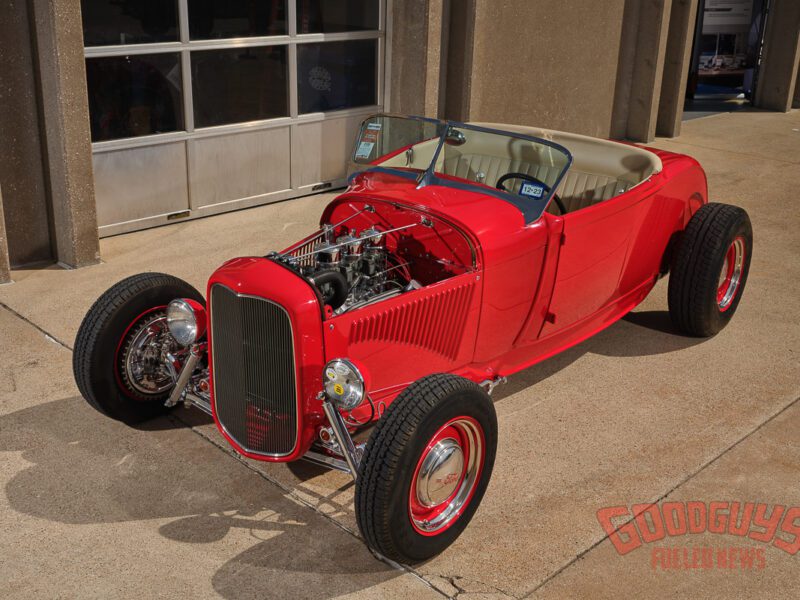Hot Rod Legends: The NieKamp Roadster – the First America’s Most Beautiful Roadster
Roadsters of all types were the cars of choice for many post-WWII vets ready to unleash their car-crazy passion after the war. In this column, we have championed some the most famous examples, including standouts by Doane Spencer, Ed Roth, Andy Brizio, Tommy Ivo, and more. Yet we’ve been negligent – we have postponed for far too long an appreciation of the Bill NieKamp ’29 Ford track-nosed roadster.
When NieKamp conceived of the car in 1949, he was in his early 40s and worked as an assembler and painter at the Plymouth factory in Long Beach. Off hours he frequented the dry lakes, where he was often taken aback by the rudimentary construction of many racing roadsters, mostly assembled by youngsters with limited budgets and nominal fabricating skills.
Could NieKamp build a hot rod that could do double duty, turning heads at car shows and racing at Southern California’s dry lakes? He decided to find out.
NieKamp picked up a ’29 Model A roadster body for $15. He channeled the body over 1927 Essex frame rails. He grafted on a Model A rear crossmember and inverted a Model A crossmember for the rear engine support, upon which purred a hotted-up ’42 Mercury Flathead. He built a front crossmember from chromoly tubing and employed a front axle from a 1939 Ford V8-60.
Out back, a 1931 Ford Model A rear spring controlled a 1939 Ford rearend with 3.54:1 gears. Both the driveshaft and torque tube required shortening. To reduce aerodynamic drag, NieKamp fitted teardrop fairings to the rear axle and spring assembly. The rear suspension also featured a unique dual shock arrangement – Houdaille dampers controlled the up and down, tube-type Gabriels minimized the body lean.
Stopping power came via 1941 Ford hydraulic brakes; a 1935 Ford cross-steering gear box told the front wheels which way to go. The roadster rolled on 15×5-inch Mercury wheels with Mobile 5.50 tires up front, and special 15×6-inch Riggs wheels in the rear.
As for the Flathead, increased dry lake power was NieKamp’s priority. The 1942 Merc flatty V8 was fortified by Evans heads, a Weiand intake manifold, Winfield cam, and Thompson three-ring pistons. NieKamp hand ported the engine.
The roadster’s iconic shape was the product of both metal man Whitey Clayton, who fabricated the belly pan, hood, and signature track nose, and NieKamp himself, who crafted the floorboard and nerf bars. All told, the car cost NieKamp just over $1,800.
Before he ever raced the car, NieKamp entered it at the 1950 Grand National Roadster show in Oakland, where it took home the inaugural America’s Most Beautiful Roadster award. That caught Hot Rod magazine’s attention, where Tom Medley photographed it for a multiple-page spread in the March 1950 issue.
Then it was off to El Mirage, where NieKamp campaigned the car for three seasons, hitting a best speed of 142 mph in 1952. At one point, NieKamp received a cash offer of $2,800 for the pink slip, which he quickly rebuffed. Rather, he kindly raffled the roadster off to benefit an injured racer. Raffle winner Dick Russell drove and raced it for the next six years before selling it to Delmer Brink.
The new owner made several changes including swapping out the Flathead for a Buick Nailhead – but he never finished the project. Enter famed hot rod builder Jim “Jake” Jacobs, who purchased the forlorn classic for $1,300 in 1969. At the time, the car was just a dated racer – Jake’s friend even asked, “Why do you want to buy an old hot rod with an ugly nose?” Jake knew better. He reinstalled a Flathead – and proceeded to drive the roadster to the second-annual Street Rod Nationals, a 2,600-mile roundtrip.
Jacobs eventually installed a small-block Chevy V8 in 1975 (donated by fellow R&C staffer Gray Baskerville), and the roadster served as Jake’s daily driver for many years, before he eventually stored it at the Petersen Museum. But when the Pebble Beach Concours opened a Hot Rod Class in 1997, Jacobs restored it back to its original 1950 condition. After the show, he hauled it back to his shop in the desert – and waited for the Petersen Museum to call. He planned to sell it to them.
In 1999, Petersen came calling, and a lengthy negotiation took place. Jake hung tough. Eventually the museum met his asking price. Jacob received a six-figure check, personally signed by Robert E. Petersen. The car remains at the museum to this day.
We caught up with Jacobs by phone at this year’s Grand National Roadster show in Pomona, where coincidently he had been inducted him into the show’s Hall of Fame hours earlier.
“I was well aware of the car’s history, so when Delmer decided to sell it, I thought I just had to have it, despite its condition,” Jacobs explained. “It was a historically significant roadster.”
Jake shared one interesting anecdote. When he originally purchased the car, he borrowed the $1,300 from his father. Three decades later, when the Petersen Museum sent a truck to pick up the car, his dad sat on a lawn chair watching the proceedings unfold. He sat dumbfounded. He couldn’t believe this little car had earned his son such a princely sum after all these years.
Then again, that’s what happens when a historic hot rod is nurtured back to its original brilliance by an equally legendary hot rodder.
Lead photo by Gary Medley, inset images courtesy Kustomrama







